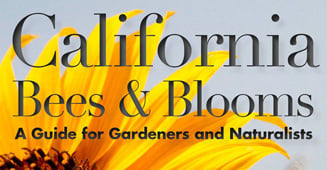

Contributor
- Topics: Archive
 When the average person hears anything about bees, it is likely to be a story about Colony Collapse Disorder, rapid population decline, or “Killer Bees”—all concerning the non-native honeybee. Our awareness of the honeybee is bolstered each time we enter our gardens when flowers are blooming. The familiar drone of bees gathering pollen and nectar is something we are well attuned to. The authors of this book would like us to look closer and see the vast array of native bees that may be present, even in the smallest cultivated urban plot.
When the average person hears anything about bees, it is likely to be a story about Colony Collapse Disorder, rapid population decline, or “Killer Bees”—all concerning the non-native honeybee. Our awareness of the honeybee is bolstered each time we enter our gardens when flowers are blooming. The familiar drone of bees gathering pollen and nectar is something we are well attuned to. The authors of this book would like us to look closer and see the vast array of native bees that may be present, even in the smallest cultivated urban plot.
Years of observation in gardens across California (many in the Bay Area and Central Valley) have gone into this field guide/reference book detailing the lives and characteristics of the major families of native bees in the state. There are 1600 species of wild bees in California! Of course not every species of native bee is covered, so the focus of the chapters on bee identification centers mainly on the more common or easily recognized species one might observe in gardens. Even when they are right in front of us, our native bees are not always easy to spot. Many native bees do not behave in ways we associate with the familiar honeybee. Most native bees do not swarm or nest in hives, and none of them make honey (at least not any that we can exploit), and many do not sting. Yet the importance of native bees as pollinators is stressed throughout the text. A number of farming communities have already recognized the important role that native bees play, especially as populations of the domesticated honeybee decline.
California Bees & Blooms also acquaints us with the best plants to attract bees. I found it interesting that native California plants, which are far better at doing the job, do not dominate the plant list. This is not a judgment by the authors, but merely an acknowledgement that most urban gardens are filled with a preponderance of exotic plant species. As more people plant gardens containing at least some native plants, it follows that they will become more aware of the native bees and insects that are attracted to these sources of nectar and pollen that they evolved with. The authors provide “recipes” for gardens to attract bees. They also provide information on creating nesting areas, and caring for gardens that work with nature instead of using harmful pesticides and other chemicals.
This guide is a well thought out and researched reference for the beginner as well as for the more seasoned naturalist. Information about insects that resemble bees or can be easily misidentified as bees, as well as a chapter on the many predators that prey on bees, further illuminates this fascinating world of wonderful insects that may already be right outside our doors. Perhaps soon people will rejoice when they find the perfectly circular cuts in a fresh leaf and know that leaf-cutter bees are present in their garden, or thrill when they are chased by a blustering Teddy Bear bee knowing full well it cannot harm them.
A useful section details citizen-led projects to protect and raise awareness of wild bees and listings for a wide variety of groups and resources to help the urban gardener create their own bee haven. After reading this book I was glad I planted more ceanothus this year—next year more wildflowers! Of course now I’ll need a hand lens—and a macro lens for the camera.
Steve Gerischer, garden designer and PHS board president
Los Angeles, California









Responses